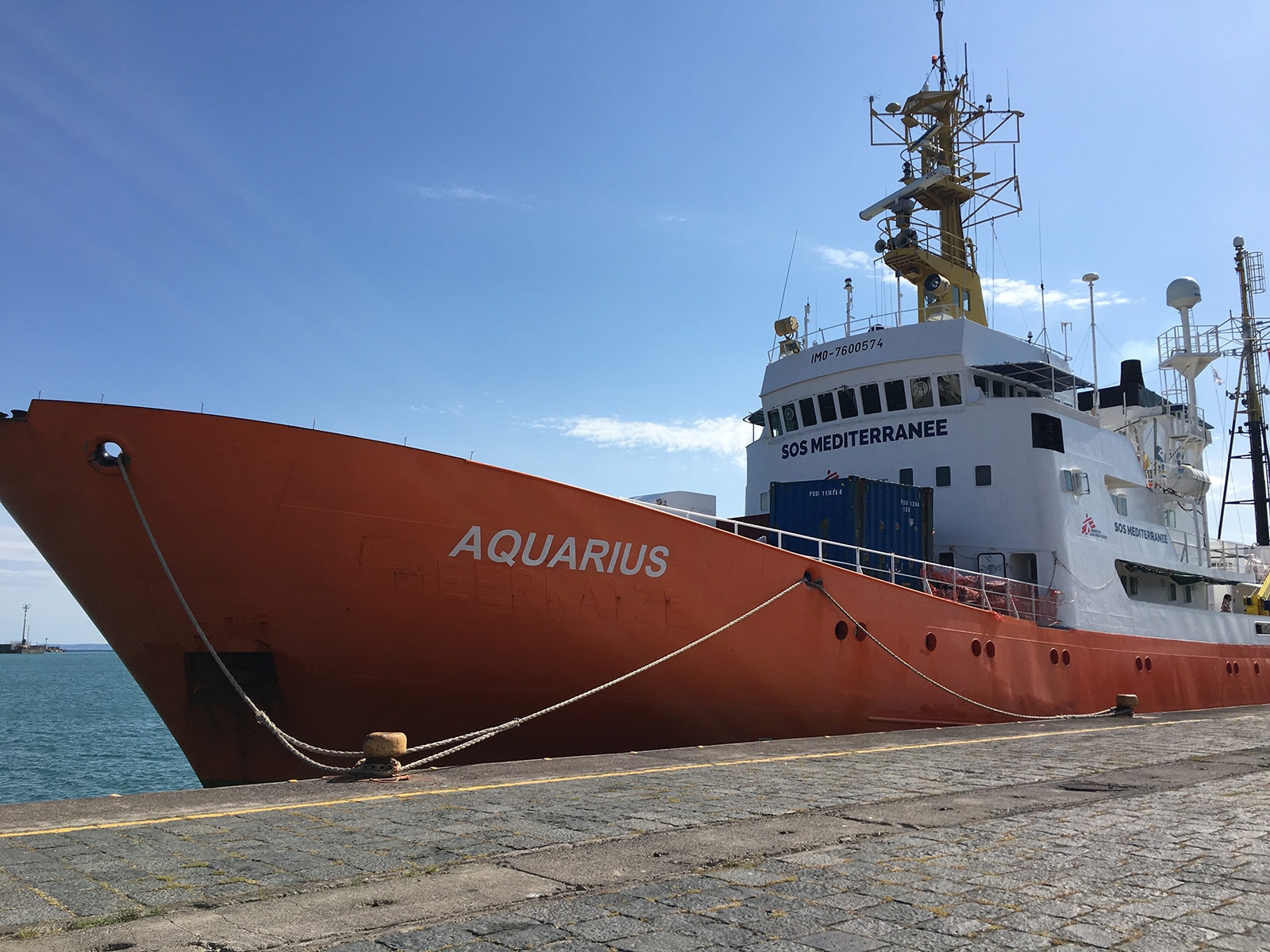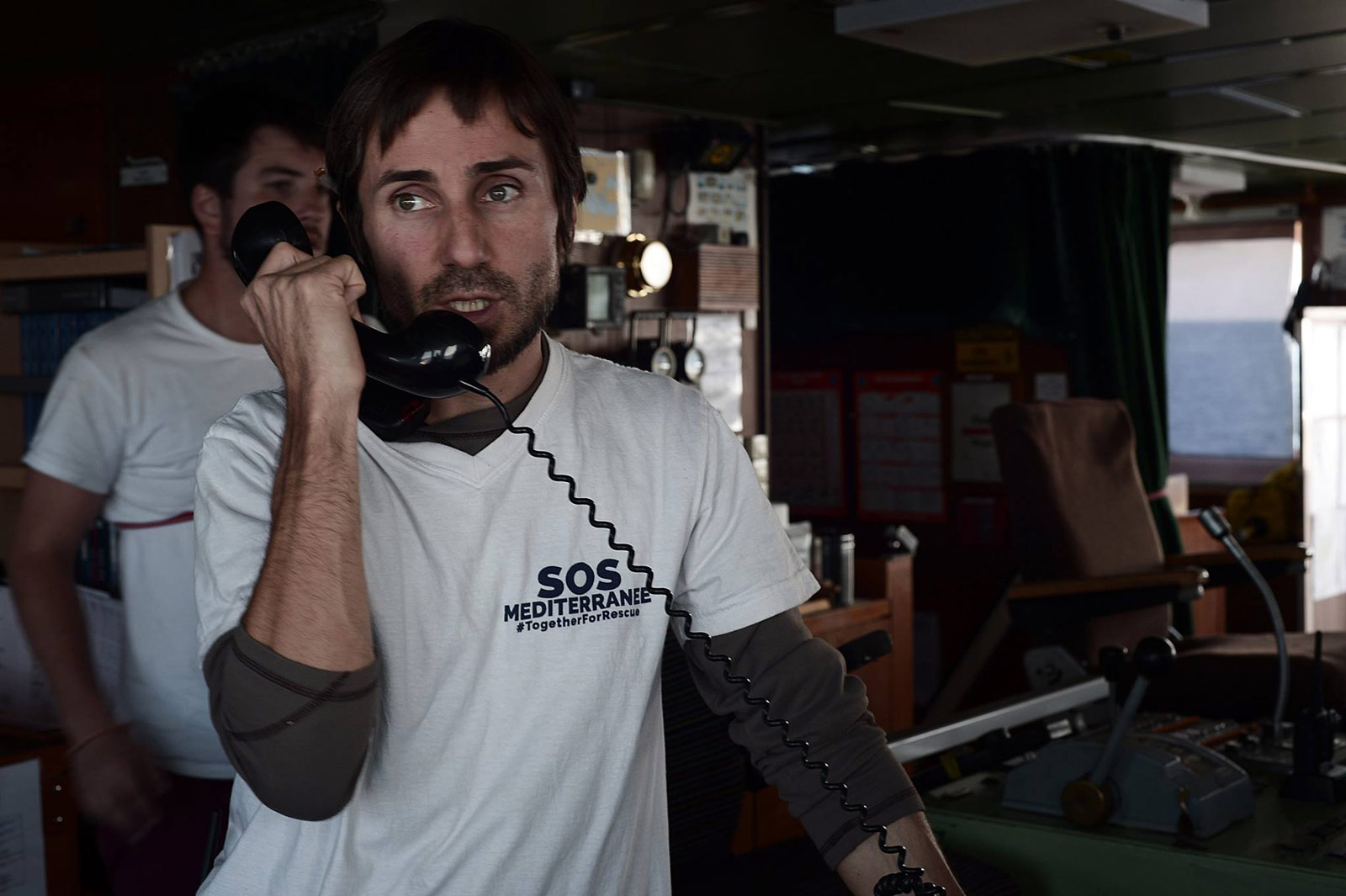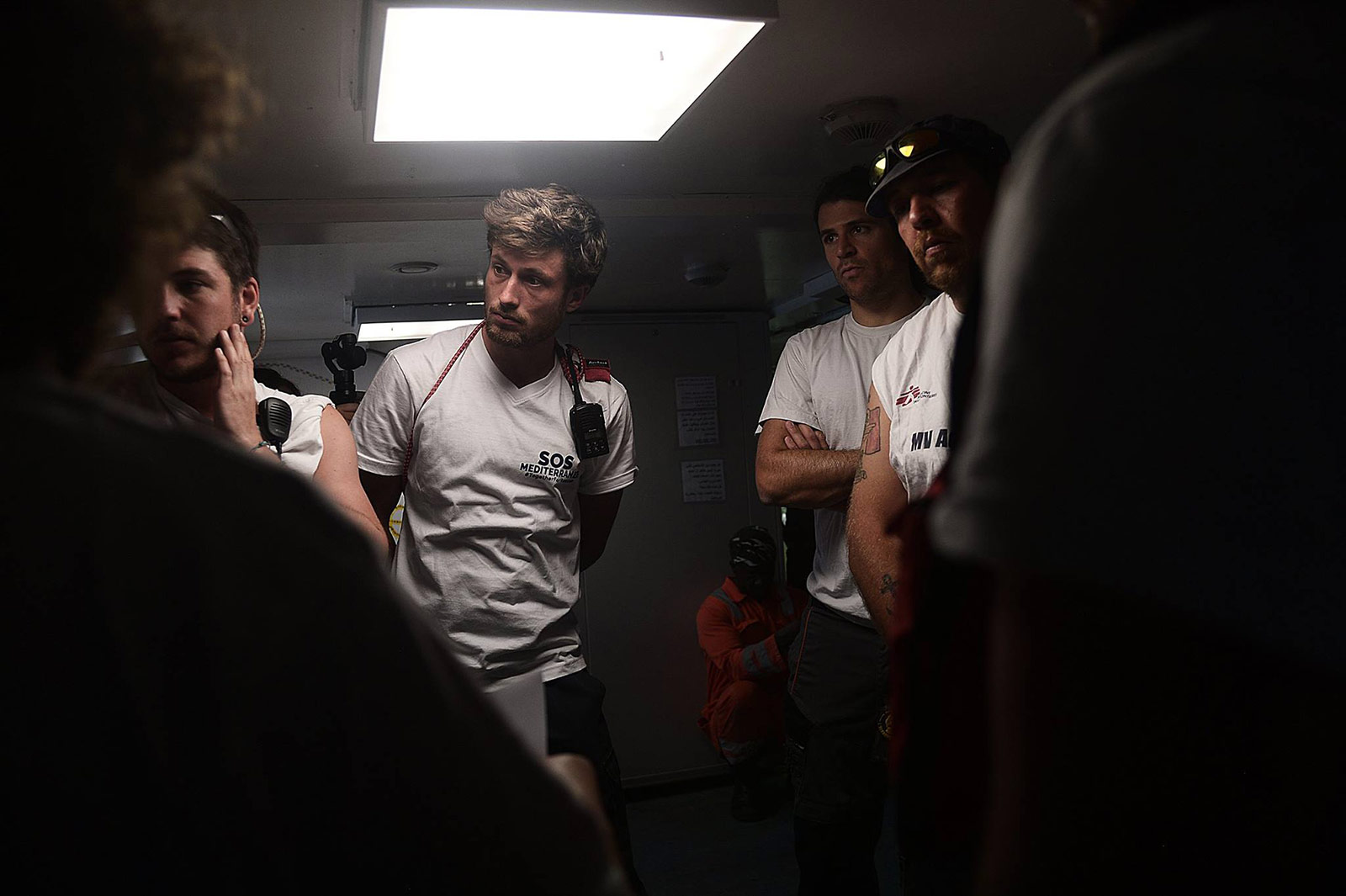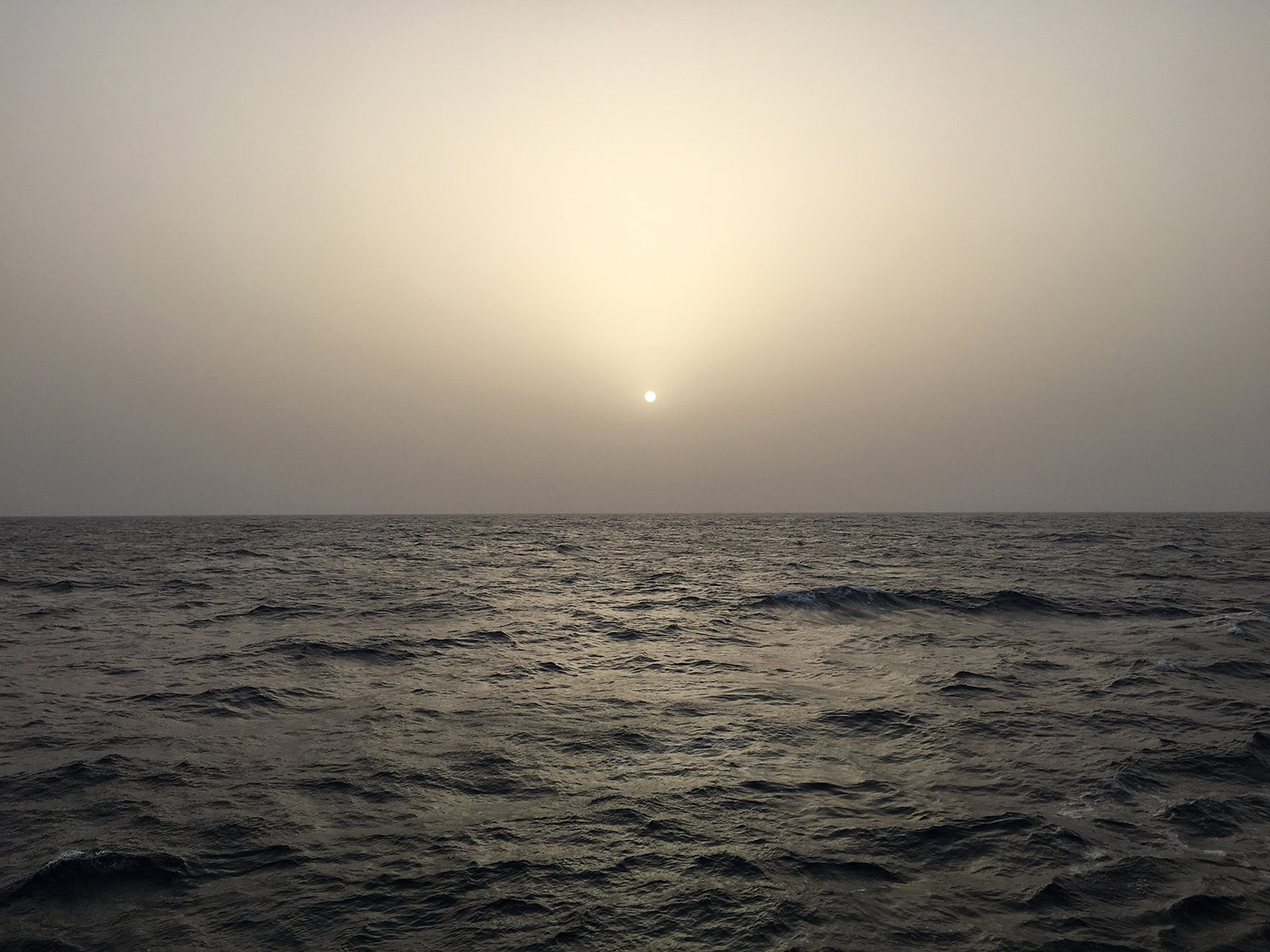

For more than a year, the Aquarius – a former fishing boat – has been cruising the Libyan coast searching for the thousands of migrants who attempt the crossing to Italy every day. Our reporter spent 10 days on board with the humanitarian workers who are on the front line of rescue operations.
They don’t turn around to look. They are probably used to seeing the volcano fade into the horizon. It’s 8:15am, the sun has already broken into the sky, and none of the sailors from the Aquarius has stayed on the stern of the ship to salute Mount Etna. The vessel is leaving the port of Catania, without so much as a second thought for the majestic volcano that seems to crush Sicily with its imposing stature, and where Hephaestus forged the weapons of the Greek gods.
The sailors all disappeared after tidying the bridge. Some have gone down into the ship, others have taken up their navigation posts. They’re used to departures, to leaving the continent and its ports, and some of them display an open fondness for heading out to sea. “The ship is my home, the sea, my garden,” one of the crew tells me. And so setting sail, even for the challenging missions that the Aquarius undertakes, is a joy.
Whether you’re black or white, whether you come from this side of the Mediterranean or the other, it doesn’t matter. There are human beings in front of you who are drowning. So you help them, that’s all there is to it.
For a little more than a year, the humanitarian ship, chartered by the young NGO SOS Méditerranée, has been scouring the mare nostrum, as the Romans called the Mediterranean, which has become the most dangerous migrant route in the world, to save migrants stranded at sea. The Aquarius is 77 metres long, with bright orange sides, and she has left an impressive record in her wake. In 15 months of service, the ship and her crew have already saved more than 11,000 people. As many lives as the sea itself has taken in less than five years. This is the old ship’s daunting task—to stop the 2.5 million square kilometres of water on which it floats from becoming humanity’s biggest mass grave.
SOS Méditerranée was started by Sophie Beau, a French woman, and Klaus Vogel, from Germany. She brought her humanitarian experience, and he, a container-ship captain, brought his maritime knowledge. After a crowdfunding campaign in 2015, they collected the one million euros needed to launch the project. Money in hand, they sought out an adequately sized boat, and settled on the Aquarius, a 611 ton ship owned by Hempel Shipping that had spent its life offering assistance to fishing vessels, until Sophie and Klaus asked it to do the same for human beings. At the end of February 2016, it left the cold Baltic for the warm coast of Sicily. One week later, it completed its first migrant rescue mission.

A year later, Nicola, Benedetta, Nicholas, Matthias, and Mary roam the ship’s corridors. It’s difficult to tell where they are going; what they’re doing, or even who they are. Sometimes they introduce themselves as the “SAR team,” explaining that they get their instructions from “SAR-Co” and that they go to smoke “on starboard.” After a few days, the acronym finally becomes clear. It stands for Search and Rescue. They operate in the “SAR zone,” off the coast of Libya, in the Gulf of Gabès, where the majority of migrant dinghies get pushed by the current, according to the UN’s International Organisation for Migration (IOM).
All of the SARs take their orders from Nicola, the SAR coordinator (SAR-Co), and SOS Méditerranée’s chief representative on board. Together, they manage rescue operations, pilot Zodiacs charged with approaching migrant vessels and facilitating the transfer of migrants on to the Aquarius, and take care of logistics. They share living space with the medical team from MSF, which is made up of a doctor, two nurses, a midwife, and a head of mission. The Aquarius is home to 35 permanent staff in total, including the crew (the captain, cooks, technicians…).

From the outset, I wonder what has motivated the youngest of the team – whose average age is 30 – to leave friends, television, football matches and parties to venture out to the limits of Libyan waters. Life onboard is subject to rigorous rules: alcohol is forbidden, the Wi-Fi is capricious, and there is no TV. Setting sail means becoming one with the sea, and forgoing the little daily pleasures of land for at least two months. To the team though, none of that matters. “We get through it because we’re in it together, we’ve become a little family,” says Anthony, a 35-year-old sailor from Corsica who is taking a break from his career in merchant shipping. “When you hear that there are people dying at sea, and that you can help them, you do it… Whether you’re black or white, whether you come from this side of the Mediterranean or the other, it doesn’t matter. There are human beings in front of you who are drowning. So you help them, that’s all there is to it.”
If we know how to figure out at what time it’s impossible to take to the sea, the smugglers do too.
The evening before, they all toasted each other one last time before leaving, in a small café near the port of Catania. Nicola, the SAR-Co, had just arrived from Rome. And then the night’s laughter and sounds of clinking glasses had given way to the next morning’s 9:00am briefing on the ship, and to the realities of what lay ahead. “You’ll have to be strong. Being here means risking seeing what nobody wants to see,” says Marcella, MSF’s mission chief, who is used to difficult work. “With MSF, we go where nobody wants to go.”
Seated in front of the small army of rescuers, Marcella and Nicola begin the meeting with an overview of the day’s meteorological conditions, as they will every following morning at sea. With the help of maps and charts that are incomprehensible to the uninitiated, the two chiefs give details on atmospheric forecasts, explain the movements of the currents, and analyse wind speeds, to zero in with an almost surgical precision on “target windows,” the places where they suspect human traffickers will launch wooden dinghies packed with migrants.
‘If we know how to figure out at what time it’s impossible to take to the sea, the smugglers do too,’ they explain. It doesn’t mean the human traffickers have a humanitarian motive; it’s pointless to launch a dinghy if the current stops it from advancing and pushes it back to shore.

The morning meetings are also the time to lay out the plan for the day, and to remind everyone about certain logistics. The Aquarius “will enter the zone” in 36 hours; it will take three days total of sailing to complete a trip. With a maximum speed of about 25 km/h, the boat struggles to make the journey any faster. Seasickness is already setting in for some. Benedetta, a member of the SAR team, tries to joke about it. “When you’re seasick, the first day you think you’re going to die. On the second and third days, you realise that unfortunately, you won’t,” she says.
Volunteering on the Aquarius involves first and foremost a battle against nausea. Lauren and Reem from the MSF team have left to go and lie down. Natalia follows soon afterwards. Marcella has taken precautions. “The first time I was on a boat I was really sick,” she says, “so this time, I cheated and took medication.”
The rest of the first day will be a long succession of briefings for the newcomers. A meeting with the captain and a tour of the boat at 10:00am. A meeting with Nicola and another tour of the boat at 11am. It’s easy to get lost. Impossible to know which staircase leads to which causeway, or how to get to the “mess room,” or dining hall.
There are areas for smoking, areas reserved for equipment, the aft deck, upper deck, main deck, bridge. Then, there are a thousand rules to follow: go down the staircases with your eyes on the steps, don’t yell because the sailors are on staggered hours, and so some are probably sleeping, don’t lock doors, don’t sit in the eating area reserved for the maritime team (the captain, his first mate, and members of the crew). At 1:00pm, there’s a new meeting about the “code of conduct” for journalists. “Don’t take pictures of the Libyan coastguards,” I am told. Don’t bother the captain, don’t harass rescued migrants, and don’t give too many details about what happens at port in Italy.
After the bustle of the first day, the night is strangely calm. The boat seems like it’s empty. Outside, darkness is falling over the water. Nothing glitters in the distance. The only sound is the crash of the waves against the sides of the Aquarius. The blackness of the sea merges with that of the sky. The hallways are empty. Smokers are rare after nine o’clock.

